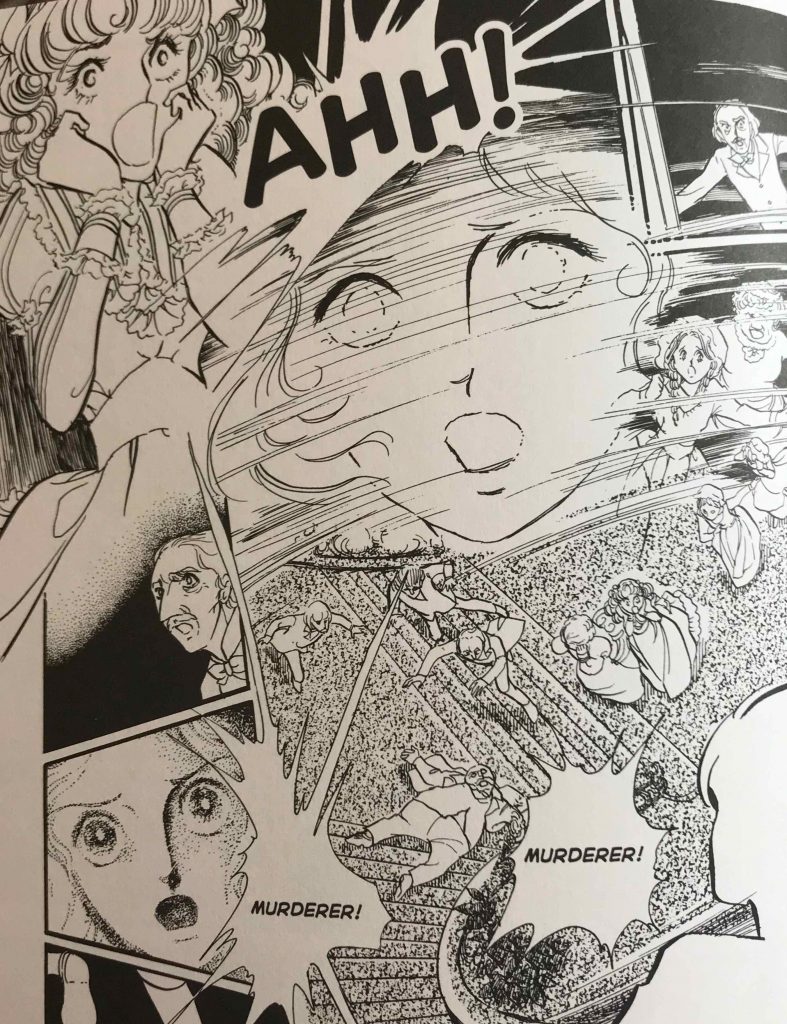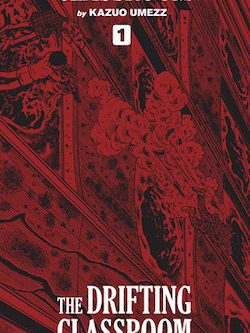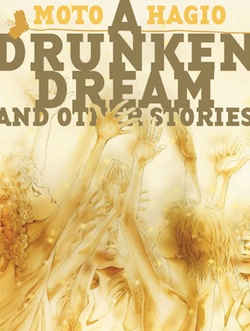Since its debut in Bessatsu Shōjo Comic, Moto Hagio’s The Poe Clan has proven almost as enduring as its vampire protagonists, living on in the form of radio plays, CD dramas, a television series, a Takarazuka production, and a sequel that appeared in Flowers forty years after the series finished its initial run. The Poe Clan’s success is even more remarkable considering that Hagio was in the formative stages of her career, having made her professional debut just three years earlier with the short story “Lulu to Mimi.” Yet it’s easy to see why this work captivated female readers in 1972, as Hagio’s fluid layouts, beautiful characters, and feverish pace brought something new to shojo manga: a story that luxuriated in the characters’ interior lives, using a rich mixture of symbolism and facial close-ups to convey their ineffable sorrow.
The Poe Clan‘s principal characters are Edgar and Marybelle Portsnell, the secret, illegitimate children of a powerful aristocrat. When their father’s new wife discovers their existence, Edgar and Marybelle’s nursemaid leads them into a forest and abandons them. The pair are rescued by Hannah Poe, a seemingly benevolent old woman who plans to induct them into her clan when they come of age. The local villagers’ discovery that the Poes are, in fact, vampirnellas (Hagio’s term for vampires) irrevocably alters Hannah’s plans, however, setting in motion a chain of events that lead to Edgar and Marybelle’s premature transformation into vampirnellas.
Though my plot summary implies a chronological narrative, The Poe Clan is more Moebius strip than straight line, beginning midway through Edgar and Marybelle’s saga, then shuttling back and forth in time to reveal their father’s true identity and introduce a third important character: Alan Twilight, the scion of a wealthy industrialist whose confidence and beauty beguile the Portsnell siblings. In less capable hands, Hagio’s narrative structure might feel self-consciously literary, but the story’s fervid tone and dreamy imagery are better served by a non-linear approach that allows the reader to immerse themselves in Edgar’s memories, experiencing them as he does: a torrent of feelings. Furthermore, Hagio’s time-shifting serves a vital dramatic purpose, helping the reader appreciate just how meaningless time is for The Poe Clan’s immortal characters; they cannot age or bear children, nor can they remain in any school or village for more than a few months since their unchanging appearance might arouse suspicion.
Hagio’s artwork further reinforces the dreamlike atmosphere through inventive use of panel shapes and placement, with characters bursting out of frames and tumbling across the page, freeing them from the sequential logic of the grid. In this scene, for example, Hagio uses these techniques to depict an act of impulsive violence—Alan pushes his uncle down a flight of stairs—as well as the reaction of the servants and relatives who bear witness to it:
While the influence of manga pioneers like Osamu Tezuka and Shotaro Ishinomori is evident in the dynamism of this layout, what Hagio achieves on this page is something arguably more radical: she uses this approach not simply to suggest the speed or force of bodies in motion, or the simultaneous reactions of the bystanders, but to convey the intensity of her characters’ feelings, a point reinforced by the facial closeups and word balloons that frame the uncle’s crumpled body.
Her method for representing memories is likewise artful. Through layering seemingly arbitrary images, she creates a powerful analogue for how we remember events—not as a complete, chronological sequence but a vivid collage of individual moments and details. In this passage, Hagio reveals why one of Edgar’s schoolmates has confessed to a theft he didn’t commit:
The final frame of this passage reveals the source of Killian’s pain: he witnessed another boy’s suicide. But Killian isn’t remembering how the event unfolded; he’s remembering the things that caught his eye—birds and branches, feet dangling from a window—and his own feelings of helplessness as he realized what his classmate was about to do.
As ravishing as the artwork is, what stayed with me after reading The Poe Clan is how effectively it depicts the exquisite awfulness of being thirteen. Alan, Edgar, and Marybelle feel and say things with the utmost sincerity, so caught up in the intensity of their emotions that nothing else matters. Through the metaphor of vampirism, Hagio validates the realness of their tweenage mindset by depicting their existence as an endless cycle of all-consuming crushes, sudden betrayals, and confrontations with hypocritical, dangerous, or bumbling adults. At the same time, however, Hagio invites the reader to see the tragedy in the Portsnells’ dilemma; they are prisoners of their own immaturity, unable to achieve the emotional equilibrium that comes with growing up.
One final note: Fantagraphics deserves special praise for their elegant presentation of this shojo classic. Rachel Thorn’s graceful translation is a perfect match for the imagery, conveying the characters’ fervor in all its adolescent intensity, while the large trim size and substantial paper stock are an ideal canvas for Hagio’s detailed, vivid artwork. Recommended.
This post was updated on August 23rd with more accurate information about the current status of The Poe Family‘s serialization in Flowers. Special thanks to Eric Henwood-Greer for the correction!
THE POE CLAN, VOL. 1 • ART AND STORY BY MOTO HAGIO • TRANSLATED BY RACHEL THORN • FANTAGRAPHICS • 512 pp. • NO RATING






Eric Henwood-Greer says:
I’m so glad for this insightful review. As a Hagio mega-fan, it always annoys me how these fantastic Fantagraphic releases seem to have been largely ignored by the manga community–including manga critics (granted, many critics probably have not received their copies yet, so this could change.) Still, I’m heartened by the fact that it seems they’ve been selling well enough that a new Hagio volume comes out every few years, even if it’s agony to wait for each one (Rachel Thorn has assured me that the concluding volume of the main series will come out next year).
My copy is still “shipping” but I’m glad to hear that it seems they’ve kept to the chronological (in terms of when they were written) sequence. Some of the myriad Japanese releases have instead put them in story chronology (much like how the Narnia Books are now officially released in story chronology and not in the order they were written) which I think is a mistake.
Some very nitpicky comments. “While the influence of manga pioneers like Osamu Tezuka and Shotaro Ishinomori is evident in the dynamism of this layout, what Hagio achieves on this page is something arguably more radical: ”
Don’t leave out pioneering shoujo creator Hideko Mizuno, in particular her seminal work Fire! (1969-71) which pioneered much of this as well (man, I’d kill for a translation of that–I’ve very slowly been working through my Japanese copy).
And it should be pointed out, Hagio is currently continuing with more Poe stories–the sequl you mention wasn’t a one off…
Katherine Dacey says:
Hi, Eric! Sorry your comments languished in spam-filter purgatory! Most of the “people” leaving comments here are ‘bots hawking Cialis, so I’ve had to adjust my moderation settings to stun.
Thank you for the extra insights into The Poe Clan‘s history and current publishing status! I had no idea that Hagio’s publisher released a chronological version of the series, but it sounds as ill-advised as Francis Ford Coppola’s TV-friendly edit of the first two Godfather movies…
As for Mizuno, you’re right that I should have mentioned her. I would love to see an English-language edition of Fire!, too, as the few pages I’ve seen are gorgeous! It would also be nice to offer readers a more nuanced picture of how shojo manga evolved over the course of the the 1960s and 1970s; right now, I think many American shojo fans are under the impression that Hagio, Takemiya, and Ikeda “invented” modern shojo because Fantagraphics and VIZ are the only publishers who’ve been willing to license pre-1980 titles.
Eric Henwood-Greer says:
Hey Katherine!
No worries–I’m just glad my post made it through all the filters.
That’s not a bad comparison–with the Godfather chronological editions. When I was first getting in Moto Hagio back in the 90s–never mind that I couldn’t read Japanese–a Japanese friend who was a high school exchange student bought a bunch of her fave of her titles for me when she was back in Japan, which included a gorgeous, three volume set of Poe Family. But, as I mentioned, they were done in “story chronology” (although the date that each story was written was included). But, as you point out, the scattered time line seems a natural part of the series.
And I completely agree with you about older shoujo manga (though, of course, I would be extremely happy to have more translations from any of the Year 24 Group. I was on an odd sort of mission to find copies of Fire! largely due to the description and image from it in Manga! Manga! My aforementioned friend said that even in Japan, it was relatively hard to find (this was 15 years back) though she ultimately found for me a beautiful three volume Bunko set from the 90s complete with colour pages. But it really is a fascinating work–starting off looking more like cutesy old-school Tezuka works (and with a somewhat naive plot–I mean our hero is thrown into jail for stealing a hat for his mother…) and by the end becomes an extremely visually complex story filled with, well, sex, drugs and rock and roll (and insane asylums). Seeing as it’s taken this long for us to get titles like Heart of Thomas or the (finally) upcoming Rose of Versailles, I know there’s virtually no chance it would ever be translated but…
Anyway–thanks again for the excellent review. I’ve shared it with a number of people who were on the fence about buying Poe Clan.
E
Eric Henwood-Greer says:
Also, if Fantagraphics continues with their Hagio releases every few years,my vote for next release is not exactly a popular choice among Western fans, but for her early 80s manga MESH which I’m a little bit obsessed with. As Hagio herself has said, it seemed to mark a stylistic (art and story) change in her work. It deals with many of the themes common to her stuff (abusive childhoods, issues with parents–though in this one the protagonist wants to kill his drug dealing father), and it’s also only about 700 pages so seems to fit the boundaries of what Fantagraphics will publish (I mean I’d love for them to tackle A Cruel God Reigns, but 17 volumes seems too much for them and would take forever–and we saw how they gave up on Wandering Son… But with Rachel Matt Thorn involved, I’m sure I’ll be happy with whatever they release (and I’m already pleased that we got more than I expected, even if it is a slow wait…)
Katherine Dacey says:
Hi,Eric–thanks for steering some readers my way! I’m grateful for the traffic, and glad to hear I helped you persuade them to check out The Poe Clan.
My secret wish is for Fantagraphics (or another publisher) to license the content in this anthology, which focuses on sci-fi shoujo stories from 1970-1980: https://www.amazon.com/Shoujo-universe-science-fiction-fantasy/dp/4845630303. I think the collection includes Hagio’s “They Were Eleven”–one of my all-time favorite short stories–as well as work by other pioneers like Keiko Takemiya. I still have a copy of VIZ’s Four Shojo Stories, but it’s falling apart, which makes re-reading it a dicey proposition!
Eric Henwood-Greer says:
I still have my Four Shoujo Stories, and am scared to read it again for fear of damaging it, as well… I was a young teen when that came out (followed by A Prime) and those manga, as well as Nausicaa and not too long after the first release of Banana Fish (which was put on hold forever after volume 7) were what really won me over to manga–so I guess that’s why my loyalty and obsession has remained with classic shoujo. I was pretty annoyed when Viz seemed to feel it wasn’t worth their while pursuing more similar titles. Recently I bought a box set of two volumes of shorter works by Hagio in French–one volume being based on her “realistic” work, and the other on her sci-fi/fantasy (there’s not a lot of Hagio in French, sadly). Much of its content is also in A Drunken Dream but among the works that aren’t covered, and I was thrilled to finally get to read, is Horizon of the East, Eternity of the West, the sequel to They Were 11. It’s terrific, and I now can’t think of the two stories without each other (it sadly doesn’t translate the series of short “Space Street” Frol and Tada comedy strips Hagio did that are in the Japanese editions of They Were 11).
Anyway, I digress–but I’m a fan, as well. And that volume you linked to looks terrific. Certainly the era is right in my wheelhouse.
While I know they’re technically shonen (though you’d be hard pressed to guess that), I *was* very glad that Vertical translated Takemiya’s Terra E and Andromeda Stories. Terra E is simply the perfect 1970s style space opera I think. I like Andromeda Stories less, but I find it underrated (it seemed like hardly anyone picked it up–Terra E had some name recognition due to the anime(s) and a mention in Manga! Manga!). What Vertical didn’t really advertise is that Takemiya only did the art for Andromeda–the writing was an original story by famous Japanese sci-fi novelist, Ryu Mitsuse. What I find interesting about that–since Takemiya and Hagio’s work so often seemed to bounce off each other, is immediately before, Hagio had did a manga adaptation of his most famous novel, Ten Billion Days and Hundred Billion Nights. I’ve not read the novel and haven’t seen the manga save for a few images, but it sounds… insane. “Plato, Buddha, Christ–what brings these men to the far future to witness the end of the world? Ten billion days—that is how long it will take the philosopher Plato to determine the true systems of the world. One hundred billion nights—that is how far into the future Jesus of Nazareth, Siddhartha, and the demigod Asura will travel to witness the end of all worlds. ”
Anyway, sorry, another tangent but thanks for the conversation and the link!
Eric Henwood-Greer says:
On a different blog, someone was asking about the actual publication dates of each individual chapter/story in magazine format. I checked my Japanese three volume set which has the dates for each installment (something I wish Fantagraphics would have done–they don’t give any dates at all, and it’s not hard to do). So far (six chapters in this volume, out of a total of fifteen) they are following the same sequence, which means already two chapters are not in the order in which they appeared in magazine format. Anyway, I thought this info might be of interest to other uber geeks besides myself who read your reviews:
Ch 1: 1/1972
Ch2: 5/1972
Ch3: 6/1972
Ch 4: 10/1972
Ch 5: 12/1973
Ch 6: 5/1973
Ch 7: 3/1975
Ch 8: 6/1975
Ch 9: 7/1975
Ch 10: 10/1975
Ch 11: 11/1974
Ch 12: 5/1975
Ch 13: 4/1975
Ch 14: 9/1975
Ch 15: 4/1976
Katherine Dacey says:
Thanks for taking the time to compile this information, Eric; I don’t know how many of my readers are proficient in Japanese, but I am sure that they will find it useful. It would be interesting to re-read the series with this timeline in hand, if only to solidify the timeline and reflect a little more on why Hagio chose a non-linear approach to the story!